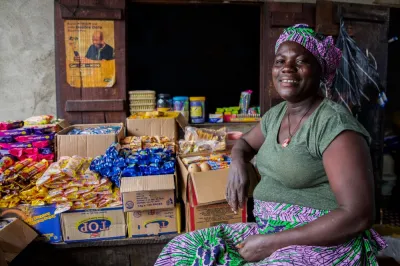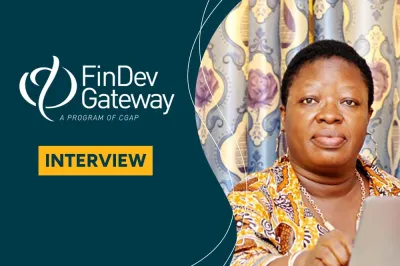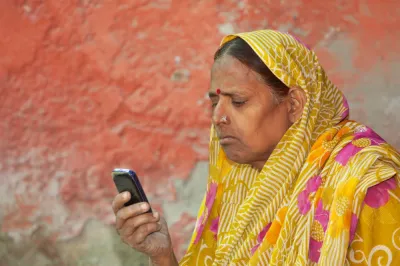Building Resilience in Real Time

Poor women living in Northern Kenya’s drylands are one drought away from slipping even deeper into economic insecurity, as such shocks threaten income from the region’s main livelihood - livestock herds managed by men. The BOMA Project has strung a safety net for these ultra-poor women by helping them launch small businesses, amass savings, get healthcare and gain life skills – all part of the graduation approach, which is designed to foster resilience and “graduate” people out of extreme poverty. Developed by Bangladesh-based NGO BRAC, the graduation approach is a promising poverty alleviation strategy now being implemented by several organizations around the world that work primarily with women in remote and impoverished areas.
These organizations need tools to manage the different components of the graduation approach effectively. Bolstering already economically vulnerable women against disruptions such as droughts, flash floods or military conflict requires constant progress monitoring. The organizations need to be able to collect and analyze field data to make real time operational and business decisions, and they want a way to coordinate the range of individuals working with program participants.
This is where TaroWorks comes in. We work with the BOMA Project, Village Enterprise and TrickleUp - all organizations implementing the graduation approach – to help them chart their workflows and identify stages of their business processes that would benefit from being digitized using our mobile field services app and cloud customer relationship management (CRM) technology.
During a recent webinar, BOMA and Village Enterprise explained how they use a combination of TaroWorks’ offline mobile app, the Salesforce cloud database and M&E tools created by Vera Solutions to monitor program performance and poverty alleviation.
“Anybody who works in the graduation space knows that when working with ultra-poor women, early intervention makes a difference between whether a woman graduates or she falls off during any stage of the program,” Monica Kundu, BOMA Project’s System Administrator, said during the webinar. “... constantly checking on how they are doing is really important because there are very many factors that affect their success – such as conflict, working together and access to knowledge.”
The BOMA Project - Detailed monitoring and fast decision-making
The BOMA Project uses mobile and cloud technology to target the best program candidates, monitor individual and group performance over each cohort’s two-year span and assess the productivity of BOMA’s field staff.

Flow chart illustrating how TaroWorks is used to facilitate the BOMA Project’s Poverty Graduation Approach. Source: The BOMA Project
Field surveys and data dashboards help BOMA qualify program participants. Data capture forms help them register and organize three-person business groups for small enterprises designed to supplement the would-be entrepreneurs’ incomes in times of economic risk. Software and hardware track business revenue and expenses as well as help administer and evaluate the skills training, which business owners receive from their BOMA field mentors.
BOMA also uses mobile devices and online analytics tools to award financial grants that recognize program participants’ progress and to administer loans the women disburse themselves through savings groups formed with BOMA’s help. These tools help BOMA work towards their overall aim of supporting ultra-poor women to achieve financial stability, a cornerstone of the graduation approach.


TaroWorks form used to collect data to monitor savings groups formed by the women entrepreneurs. Source: BOMA Project
Having quick access to up-to-date data lets BOMA make crucial business decisions. For example, information on the detailed performance of each business created and run by the women helps business mentors figure out what ventures to suggest for new program applicants. Tracking program registration data as it is uploaded to Salesforce helps BOMA make sure they are taking the right actions to meet registration quotas.
Village Enterprise - The importance of two-way data flow
For Village Enterprise, which operates a one-year graduation program in Uganda, the ability to track outcomes in real time became crucial when they introduced a new “payment-for-results” funding and investment model called the Development Impact Bond (DIB), Outcome funders like USAID and DFID have committed $5.8 million dollars for their project, which aims to support the creation of over 4,000 sustainable microenterprises in 3.5 years. However, with this unique financing model, Village Enterprise and the impact investors will only receive the outcome payments from funders when clearly-defined and rigorously-measured outcomes on increased participant household income are met. With such high stakes, it was imperative for Village Enterprise to digitize operations and access real time business decision-making data.
Celeste Brubaker, Monitoring, Evaluation and Learning Director at Village Enterprise, shared during the webinar that while Village Enterprise had been using Android mobile devices to collect data from the field since 2011, they were searching for a method to push analysis and results gleaned from that data back out to the field effectively. Not only was it important to know program outcomes accurately and quickly in order to trigger DIB funding, but also Brubaker said that “staff feedback was that it was taking too long to get the business monitoring results back to them and when the results were returned the plethora of information made it tough to form evaluative judgments regarding the health of businesses. In response to that we developed a business health classification system and operationalized getting the monitoring results back to staff in real time through backend automations and (data) dashboards.”

Salesforce dashboard which visualizes field data used for business decision making. Source: Village Enterprise.
Village Enterprise uses TaroWorks and Salesforce to monitor business health. Mobile and cloud technology are also deployed to log mentoring sessions and verify attendance by collecting photographs, digital signatures and GPS coordinates of all session attendees. Field staff can access data dashboards through their mobile devices to check progress and spot trends.
Lessons learned from a technology-fueled poverty graduation approach
While Village Enterprise has taken advantage of new technology to help them manage and evaluate their programs, Brubaker says that through this process they have also learned that “technology alone will not move an organization into a high capacity adaptive management space. Leaders across Village Enterprise invest energy in creating a culture that manages adaptively based on evidence.”
Kundu from the BOMA Project pointed out that keeping the field staff and their needs front and center is also important. “Focus on what you want to achieve, who is going to help you achieve your impact and as you design your program and as you design your solutions, focus on the end user, who is going to use it, because if you design difficult forms they may not be able to collect the data for you,” she said.


